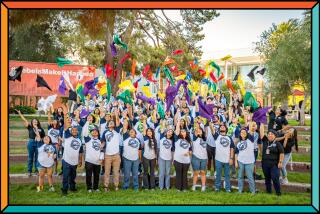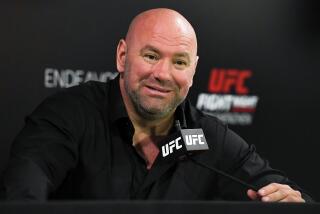Shark Bites Vegas : Culture: The fight between UNLVâs president and basketball coach is pushing glitz city to an identity crisis.
LAS VEGAS â From the roof of the humanities building at the University of Nevada, Las Vegas, you can look out over the desert and envision two cities: the seedy, glitzy old Vegas of Bugsy Siegelâs days, and the proud, important new Las Vegas that city boosters say is already taking shape.
This seven-story building, which houses the administration offices, is also the epicenter of a rumble that some citizens--with typical Vegas hype--think might shake this city of 700,000 back into desert dust.
UNLV President Robert Maxson is painfully aware of the shock waves as he looks out over his campus, a rolling landscape embellished with olive and palm trees and elegant sculptures. In keeping with that vision of a new Las Vegas, Maxson points out the modernistic health sciences building that President Bush so admired when they jogged together recently. He waxes eloquent about the Computing Center for Energy and Environment that houses the schoolâs coveted $10-million Cray supercomputer.
But Maxson seems to ignore the most prominent building on campus, a dazzling $30-million edifice financed with slot machine taxes and launched in 1984 with a groovy gala featuring Vegas royalty: Frank and Dean and Diana.
Ten hours later, 18,944 fanatical followers of the Runninâ Rebels basketball team will flood into that circular building--the Thomas and Mack Center--decked out in every imaginable combination of UNLV red and gray. But many also will wear T-shirts and carry signs and shout chants that offer variations on another theme: âKeep Tark--Fire Maxson.â
To anyone in Las Vegas, that slogan has become shorthand for a convoluted confrontation that began, for all practical purposes, 19 years ago when Jerry (âTark the Sharkâ) Tarkanian came here to coach. In a city built by games, the Runninâ Rebels were--and still are--the only real game in town. As Tarkanianâs teams began winning championships, a city long lacking in self-esteem responded with overwhelming appreciation. When the arena opened in 1984, fans dubbed it the Shark Tank, and booted the old Rebel mascot for a dancing shark.
But with success, Tarkanian also brought controversy, including ceaseless squabbles with the NCAA that resulted in a suspension from tournament play. Detractors asserted that the winningest coach in college basketball won, in part, by exploiting inner-city African Americans--a charge that gained credibility when recruit Lloyd Daniels was busted in 1987 for buying crack before he played his first game for UNLV.
Most recently, the Las Vegas Review-Journal reported a federal investigation into possible point shaving, and published a photo of three players in a hot tub with a man known for âfixingâ sporting events.
Criticism of Tark and his team came with such consistency that Sports Illustrated recently hinted that he might also be charged with âinvading Kuwait, prolonging the S&L; crisis, squeezing the toothpaste from the wrong end, and being responsible for Vanilla Ice.â
Last June, Tarkanian agreed to resign two years before his contract expired. Last Tuesday was supposed to be his final game, to his detractorsâ relief. But, three weeks ago, Tarkanian rescinded his resignation and accused the UNLV administration and its supporters of attempting a coup of sorts, complete with the surreptitious videotaping of an allegedly illegal practice with a camera mounted in heating ducts--âCamScamâ in the local parlance.
And the accusations, rumors, petition drives, rallies, lawsuits and dueling press conferences intensified.
Headlines and sound bites present the affair in prize-fighting terms as a slugfest between Tarkanian, who arrived in 1973 and injected the city with a sense of pride, and Maxson, the aggressive academic who arrived nine years later to say that a cityâs pride should be based on more than just basketball.
What the Tark-Maxson affair really reflects is a complex case of a city struggling with a multiple personality disorder, wrestling awkwardly with the opposing qualities that define it, attempting to agree upon an image.
âI think it would take a lot more than Tarkanian to hurt the image of this town,â snorts Hank Groschadl, one of about 200 people sitting at the Stardust Casinoâs sports book, where bettors watch three dozen TVs broadcasting perhaps a dozen games that the casino takes bets on.
âWhatâs hurting this town is youâve got a guy whoâs well liked whoâs being crucified,â he says. âTark put UNLV on the map. I donât believe Iâve heard about the guy who just cured cancer, or the guy who did the first bypass operation on a pig coming from UNLV. Itâs known for basketball.â
Such an observation makes Elaine Wynn sigh.
As a trustee and former chair of the private UNLV Foundation and director of Mirage Resorts, Wynn embodies the cityâs complex identity crisis. Wynnâs suite in the executive offices of the Mirage Hotel is decorated in understated corporate chic, but outside swarms of people crank away on chattering slot machines, dolphins frolic in a man-made lake, Siberian tigers snooze in a glass cage and a 54-foot volcano fire flames 40 feet into the air in front of the hotel.
âItâs really becoming a morality play,â she says of the Tarkanian-Maxson showdown, adding that the underlying issue is basic: âWhat are we really all about?â
The Las Vegas of today is âmultilayered,â she says. âThe people who live here donât have to be limited by what we offer our guests. Just because we have shows that are popularly oriented doesnât mean my waitresses donât want to take their kids to see the Dance Theatre of Harlem.â
And the Dance Theatre of Harlem did indeed just perform on the campus of UNLV, about half a mile or so from where Siegfried and Roy do their shtick at the Mirage.
âThe university has become the source of most of the cultural activities in the community,â Wynn says, running down a list of achievements: a ballet company, the Nevada dance theater, the Las Vegas symphony, the opera and a lecture series that has brought such notables as Henry Kissinger to town.
âEnlightenedâ or âprogressiveâ people in the community have been working on this parallel cultural revolution for years, she says. Bringing Maxson to the campus from the University of Houston was part of the plan. And for a while, the plan was ârolling merrily along . . . For the first time (UNLV) wasnât Tumbleweed Tech anymore. We were proud of ourselves.â
Even the national media began taking Las Vegas more seriously. But there was a rub.
âEvery positive story had a negative footnote and it always focused on the basketball program,â Wynn says. Even when the allegations against the program couldnât be proved, âthere was a public perception of truth.â
Says Maxson: âIâve never been anywhere where the citizens so desperately wanted their city to be a great city, and thereâs not a great city in America that doesnât have a great university . . . I get a little bit worried that there are some people who see the University only recreationally, as a form of entertainment, (as if) basketball is the greatest asset that we have to offer. I think thatâs unhealthy.â
This kind of talk triggers a scatological synonym for ânonsense!â from Tarkanian: âThereâs not one single thing theyâve ever proposed in the area of academics we didnât thoroughly support.â
The real issue, for many Tark supporters is that Maxson never came out of his ivory tower to mix with the real Vegas.
âThereâs a sense that Maxson is an outsider, that he only courted a handful of politically active supporters,â says Jackie McCall, organizer of Citizens for Academic Freedom, a group organized to investigate âthe abuse of powerâ by the administration. âHe never wanted to know this community.â
Tarkanian and Vegas, on the other hand, were a perfect match.
âLas Vegas was and is a melting pot. It attracts people from all over. Tark single-handedly drew the communities together,â she says. âHeâs an integral part of the community, not just a great basketball coach.â
Tarkanian supporters point to his aggressive recruitment of inner-city kids not as a criticism, but as an indication of how he has brought Las Vegasâ black and white communities together.
A poll of UNLV students by the Rebel Yell student paper last week showed 66% of the students supported Tarkâs staying as coach and 42% favored keeping Maxson.
Maxson is âdeeply embarrassedâ by the cat fighting.
Tarkanian seems to relish the way his resignation has shaped up as a mano-a-mano contest. But thatâs always been his style.
In the Runninâ Rebels, he says, Las Vegas found a symbol of unity and loyalty.
âFans love to see people play hard. The degree of intensity our kids play with is really unbelievable . . . I think Las Vegas likes winners because of the nature of the industry here--if you lose all the time you canât survive.â
On the day of what the universityâs administration said would be Tarkanianâs last game, however, Little Caesars Sports Book on the Strip was jokingly listing the odds at 3-1 against Tarkâs staying.
The final game at Thomas and Mack wasnât much different than the standard Runninâ Rebels show. Roman candles and skyrockets exploded into the rafters and the shark mascot somersaulted around the floor. Electronic billboards displayed snapping sharks and the band blared the âJawsâ theme while the full house did its trademark shark clap, a blood-thirsty, from-the-shoulders gesture that makes the âtomahawk chopâ look sensible.
Of course, the Rebels beat Utah State, giving them a record of 26-2. Then the crowd joined in an emotional tribute to the 61-year-old coach. Finally, 9,000 or so of Tarkanianâs closest friends reconvened at the Sands Hotel and Casino for a party.
Pushing through the casino, they came in throngs: young men in hip-hop fashion, middle-aged couples in slick suits and gowns, old men and women wearing UNLV jackets and pins and sweaters and caps, all assuming an intimacy with the bald, slouching man who sat behind a red velvet VIP rope.
Most took time to sign an enormous wall banner: âThanks for all youâve done to make this city great.â Many added their names to petitions circulated by attorney Pat Clary of the Committee to Save Tarkanian, pushing the total to 55,000.
Tarkanian says heâs really just trying to âget out the truthâ about the administrationâs treatment of him. Clary says his committee is determined to keep Tarkanian coaching the Rebels: âWe want him to stay, we want the Board of Regents to do the courageous thing and exercise their option (to reinstate him).â
The process, he figures, will go on for months. âI disagree that this is tearing the city apart,â Clary says. âI think itâs a good lesson in participatory democracy.â
Len Banker, a well-known professional gambler, has a Vegas kind of idea for settling the whole thing quickly.
âI think they should take the whole thing to Judge Wapnerâs court,â he says. âDo it pay-per-view.â
But Alan Feldman, vice president of public relations for the Mirage, offers a more sobering image of the fallout from the Tarkanian-Maxson tiff:
âIâm afraid it will be like waking up with a bad hangover, and finding the damage you did to the living room.â
More to Read
The biggest entertainment stories
Get our big stories about Hollywood, film, television, music, arts, culture and more right in your inbox as soon as they publish.
You may occasionally receive promotional content from the Los Angeles Times.










